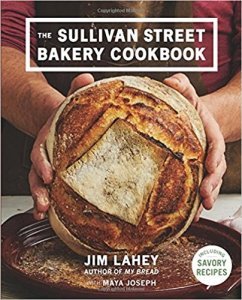Review: The Sullivan Street Bakery Cookbook, Jim Lahey with Maya Joseph
 The Sullivan Street Bakery Cookbook by Jim Lahey, Maya Joseph, Squire Fox
The Sullivan Street Bakery Cookbook by Jim Lahey, Maya Joseph, Squire Fox Published by W. W. Norton Company ISBN: 0393247287
on November 7th 2017
Genres: Cooking
Pages: 240
Format: Hardcover
Buy on Amazon
Goodreads

Founded in 1994, Sullivan Street Bakery is renowned for its outstanding bread, which graces the tables of New York’s most celebrated restaurants. The bread at Sullivan Street Bakery, crackling brown on the outside and light and aromatic on the inside, is inspired by the dark, crusty loaves that James Beard Award-winning baker Jim Lahey discovered in Rome.
Jim builds on the revolutionary no-knead recipe he developed for his first book, My Bread, to outline his no-fuss system for making sourdough at home. Applying his Italian-inspired method to his repertoire of pizzas, pastries, egg dishes, and café classics, The Sullivan Street Bakery Cookbook delivers the flavors of a bakery Ruth Reichl once called "a church of bread."
I think I ordered this book after reading about it on some sort of best-of-2017 cookbooks list. I am trying my hand at baking bread, and I really wanted to step up the challenge by trying sourdough baking. Back in December, I made my own sourdough starter using this recipe from King Arthur Flour. Jim Lahey includes his own starter recipe in The Sullivan Street Bakery Cookbook. I followed Lahey’s instructions to make my starter into biga, the stiff starter Lahey uses in many of his recipes. After I made my biga, I tucked it away in the refrigerator because I knew I wouldn’t have enough time to experiment with it. Lahey says that unlike regular starter, biga doesn’t need to be “fed” and will keep pretty much as long as you want it in the refrigerator.
I don’t know if it matters whether or not your biga is brought to room temperature after it’s been refrigerated, but I didn’t bother with it when I decided to try out the recipe for pane bianco, Lahey’s recipe for a no-knead sourdough bread. Until I used this recipe, the only sourdough bread I’d made was King Arthur’s sort of cheater recipe for “rustic” sourdough bread. I call it a cheater recipe because it uses yeast and doesn’t rely strictly on the sourdough starter to rise, which makes it good for beginners. It tastes fine, but I wasn’t happy with it. In looking through the recipes in Lahey’s book, I settled on the pane bianco because it seemed the least fiddly (there are a lot of very fiddly recipes in this book). Word of caution: it is extremely time-consuming—not in the amount of work you need to do, but in wait time.
Lahey’s instructions said that after combining the water and biga with the flour and salt the recipe calls for, you might need to wait anywhere from eight to eighteen hours for the bread to double in size. 



